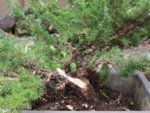No, it’s not to my taste. Trunk movement should be somewhat consistent and have a rhythm/flow from the bottom to the top; tell a story. If you are trying to make this into a finished product at its current size, follow what I already suggested above. If you want to fatten this up, read below.
When I wire trunks like this, I try to get lots of dramatic movement right from the soil line, in 3-dimensions, and then let them grow for a while so that movement really sets in. When trunks thicken, that movement becomes a little more relaxed and less contrived.
The examples below started out the size of yours, about 6 years ago. They were wired once, planted in the ground and allowed to grow mostly unchecked, with the exception of removing wire, and maybe a strike of Shari. This spring, I dug them up, picked a few potential trunk lines, just like you did, and wired more movement into them. Next year, I’ll remove the wire and let them continue to grow and fatten up. If I’m lucky, something will show up that will have some interesting movement and help establish the continuing trunk line. In another 6-8 years, these will be 6” diameter trunks, with twists and turns, and deadwood, hopefully some character, and a trunk that will tell a story. By the way, notice the way the wire is doing it’s job, because it was applied correctly. Twists made in the direction the wire was applied will tighten the wire and secure the branches better. 60-degree angles provide holding power, and allow some room for these twists and bending tha puts the wire in the outside of curves reduces the risk of blowing out a branch at the bend.
View attachment 238739View attachment 238740





